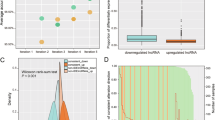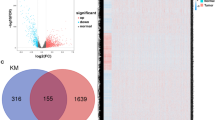Abstract
The current understanding of breast cancer (BC) progression and prognosis related to Anoikis-associated long noncoding RNAs (lncRNAs) is limited. The objective of this study is to investigate the prognostic relevance of these long non-coding RNAs (lncRNAs) and their association with the tumor microenvironment (TME) in breast cancer. We acquired RNA sequencing data and clinical records from breast cancer patients in The Cancer Genome Atlas (TCGA). These individuals were categorized into low- and high-risk groups based on their median risk scores. To identify seven prognostically significant lncRNAs linked to Anoikis, we employed a series of statistical analyses, including univariate Cox regression, the least absolute shrinkage selection operator (LASSO) regression, and multivariate Cox regression. Finally, we established a prognostic model involving seven Anoikis-related lncRNAs: GAS1RR, LINC01929, LINC01235, LINC02676, MAPT-IT1, TFAP2A-AS1, and LINC02446. Utilizing this model, we observed that patients classified as high-risk experienced a less favorable prognosis compared to their low-risk counterparts. Multifactorial Cox regression analysis validated the reliability of the risk score as an indicator of prognosis. ROC curve analysis confirmed its predictive accuracy. The functional enrichment analysis revealed a notable concentration of differentially expressed genes in immune-related pathways. Subsequently, utilizing single-sample gene set enrichment analysis (ssGSEA), we illustrated that low-risk BC patients displayed significant immune cell infiltration and enrichment in immune-related pathways, suggesting a more favorable response to immunotherapy. Furthermore, drug sensitivity analysis revealed enhanced efficacy of standard chemotherapeutic agents in low-risk patients. Our novel model is a valuable tool for predicting survival in breast cancer (BC) patients, making it applicable in clinical practice.



Similar content being viewed by others
Data Availability
The data can be found here: https://portal.gdc.cancer.gov/repository.
References
Sung H, Ferlay J, Siegel RL, Laversanne M, Soerjomataram I, Jemal A et al (2021) Global Cancer Statistics 2020: GLOBOCAN estimates of incidence and mortality worldwide for 36 cancers in 185 countries. CA: A Cancer J Clin 71(3):209–49. https://doi.org/10.3322/caac.21660
Hong R, Xu B (2022) Breast cancer: an up-to-date review and future perspectives. 42(10):913–36. https://doi.org/10.1002/cac2.12358
Pondé NF, Zardavas D, Piccart M (2018) Progress in adjuvant systemic therapy for breast cancer. Nat Rev Clin Oncol 16(1):27–44. https://doi.org/10.1038/s41571-018-0089-9
Liang Y, Zhang H, Song X, Yang Q (2020) Metastatic heterogeneity of breast cancer: molecular mechanism and potential therapeutic targets. Semin Cancer Biol 60:14–27. https://doi.org/10.1016/j.semcancer.2019.08.012
Yersal O, Barutca S (2014) Biological subtypes of breast cancer: prognostic and therapeutic implications. World J Clin Oncol 5(3):412–24. https://doi.org/10.5306/wjco.v5.i3.412
Zhou X, Li L, Guo X, Zhang C, Du Y, Li T et al (2022) HBXIP induces anoikis resistance by forming a reciprocal feedback loop with Nrf2 to maintain redox homeostasis and stabilize Prdx1 in breast cancer. NPJ Breast Cancer 8(1):7. https://doi.org/10.1038/s41523-021-00374-x
Paoli P, Giannoni E, Chiarugi P (2013) Anoikis molecular pathways and its role in cancer progression. Biochimica et Biophysica Acta (BBA) - Mol Cell Res 1833(12):3481–98. https://doi.org/10.1016/j.bbamcr.2013.06.026
Jang E-J, Sung JY, Yoo H-E, Jang H, Shim J, Oh E-S et al (2021) FAM188B downregulation sensitizes lung cancer cells to anoikis via EGF R downregulation and inhibits tumor metastasis in vivo. Cancers (Basel) 13(2):247. https://doi.org/10.3390/cancers13020247
Yu Y, Song Y, Cheng L, Chen L, Liu B, Lu D et al (2022) CircCEMIP promotes anoikis-resistance by enhancing protective autophagy in prostate cancer cells. J Exp Clin Cancer Res 41(1):188. https://doi.org/10.1186/s13046-022-02381-7
Zhang H, Fredericks T, Xiong G, Qi Y, Rychahou PG, Li J-D et al (2018) Membrane associated collagen XIII promotes cancer metastasis and enhances anoikis resistance. Breast Cancer Res 20(1):116. https://doi.org/10.1186/s13058-018-1030-y
Ma MZ, Chu BF, Zhang Y, Weng MZ, Qin YY, Gong W et al (2015) Long non-coding RNA CCAT1 promotes gallbladder cancer development via negative modulation of miRNA-218–5p. Cell Death Dis 6(1):e1583. https://doi.org/10.1038/cddis.2014.541
Beermann J, Piccoli M-T, Viereck J, Thum T (2016) Non-coding RNAs in development and disease: background, mechanisms, an d therapeutic approaches. Physiol Rev 96(4):1297–325. https://doi.org/10.1152/physrev.00041.2015
Smolarz B, Zadrożna-Nowak A, Romanowicz H (2021) The role of lncRNA in the development of tumors, including breast cancer. Int J Mol Sci 22(16):8427. https://doi.org/10.3390/ijms22168427
Bin X, Hongjian Y, Xiping Z, Bo C, Shifeng Y, Binbin T (2018) Research progresses in roles of LncRNA and its relationships with breast cancer. Cancer Cell Int 18:179. https://doi.org/10.1186/s12935-018-0674-0
Zhang Y-Y, Li X-W, Li X-D, Zhou T-T, Chen C, Liu J-W et al (2022) Comprehensive analysis of anoikis-related long non-coding RNA immune infiltration in patients with bladder cancer and immunotherapy. Front Immunol 13:1055304. https://doi.org/10.3389/fimmu.2022.1055304
Li B, Chan HL, Chen P (2019) Immune checkpoint inhibitors: basics and challenges. Curr Med Chem 26(17):3009–25. https://doi.org/10.2174/0929867324666170804143706
Adeshakin FO, Adeshakin AO, Afolabi LO, Yan D, Zhang G, Wan X (2021) Mechanisms for modulating anoikis resistance in cancer and the relevance of metabolic reprogramming. Front Oncol 11:626577. https://doi.org/10.3389/fonc.2021.626577
Yuan J-h, Yang F, Wang F, Ma J-z, Guo Y-j, Tao Q-f et al (2014) A long noncoding RNA activated by TGF-β promotes the invasion-metastasis cascade in hepatocellular carcinoma. Cancer Cell 25(5):666–81. https://doi.org/10.1016/j.ccr.2014.03.010
Lucere KM, O’Malley MMR, Diermeier SD (2020) Functional screening techniques to identify long non-coding RNAs as therapeutic targets in cancer. Cancers (Basel) 12(12):3695. https://doi.org/10.3390/cancers12123695
Baba SK, Baba SK, Mir R, Elfaki I, Algehainy N, Ullah MF et al (2023) Long non-coding RNAs modulate tumor microenvironment to promote metastasis: novel avenue for therapeutic intervention. Front Cell Dev Biol 11:1164301. https://doi.org/10.3389/fcell.2023.1164301
Xiong Z, Ge Y, Xiao J, Wang Y, Li L, Ma S et al (2022) GAS1RR, an immune-related enhancer RNA, is related to biochemical recurrence-free survival in prostate cancer. Exp Biol Med (Maywood) 248(1):1–13. https://doi.org/10.1177/15353702221131888
Salimian N, Peymani M, Ghaedi K, Mirzaei S, Hashemi M (2023) Diagnostic and therapeutic potential of LINC01929 as an oncogenic LncR. Pathol Res Pract 244:154409. https://doi.org/10.1016/j.prp.2023.154409
Jiang T, Wang Y, Chen X, Xia W, Xue S, Gu L et al (2023) Neutrophil extracellular traps (NETs)-related lncRNAs signature for predicting prognosis and the immune microenvironment in breast cancer. Front Cell Dev Biol 11:1117637. https://doi.org/10.3389/fcell.2023.1117637
Yao Z-Y, Xing C, Cai S, Xing X-L (2022) Development and validation of ferroptosis-related lncRNAs as prognosis and diagnosis biomarkers for breast cancer. Biomed Res Int 2022:2390764. https://doi.org/10.1155/2022/2390764
Zhou B, Guo H, Tang J (2019) Long Non-Coding RNA TFAP2A-AS1 Inhibits cell proliferation and invasion in breast cancer via miR-933/SMAD2. Med Sci Monit 25:1242–53. https://doi.org/10.12659/MSM.912421
Zhang Y, Ma L, Zhang T, Li P, Xu J, Wang Z (2021) Long noncoding RNA TFAP2A-AS1 exerts promotive effects in non-small cell lung cancer progression via controlling the microRNA-548a-3p/CDK4 axis as a competitive endogenous RNA. Oncol Res 29(2):129–39. https://doi.org/10.32604/or.2022.03563
Yang K, Niu Y, Cui Z, Jin L, Peng S, Dong Z (2022) Long noncoding RNA TFAP2A-AS1 promotes oral squamous cell carcinoma cell growth and movement via competitively binding miR-1297 and regulating TFAP2A expression. Mol Carcinog 61(9):865–75. https://doi.org/10.1002/mc.23438
Tong H, Li T, Gao S, Yin H, Cao H, He W (2021) An epithelial-mesenchymal transition-related long noncoding RNA signature correlates with the prognosis and progression in patients with bladder cancer. Biosci Rep 41(1):BSR20203944. https://doi.org/10.1042/BSR20203944
Pei X, Wang X, Li H (2018) LncRNA SNHG1 regulates the differentiation of Treg cells and affects the immune escape of breast cancer via regulating miR-448/IDO. Int J Biol Macromol 118(Pt A):24–30. https://doi.org/10.1016/j.ijbiomac.2018.06.033
Wei B, Kong W, Mou X, Wang S (2019) Comprehensive analysis of tumor immune infiltration associated with endogenous competitive RNA networks in lung adenocarcinoma. Pathol Res Pract 215(1):159–70. https://doi.org/10.1016/j.prp.2018.10.032
Funding
This work was supported by the Key Project of the Natural Science Foundation of Fujian Province (2021J011374).
Author information
Authors and Affiliations
Contributions
(I) Conception and design: FL, HL, JS; (II) administrative support: YC; (III) provision of study materials or patients: JS, ZL; (IV) collection and assembly of data: FL, HL; (V) data analysis and interpretation: FL; (VI) manuscript writing: all authors; (VII) final approval of manuscript: all authors. FL and HL contributed equally to this work.
Corresponding author
Ethics declarations
Ethics Approval and Consent to Participate
Not applicable.
Consent for Publication
Not applicable.
Conflict of Interest
The authors declare no competing interests.
Additional information
Publisher's Note
Springer Nature remains neutral with regard to jurisdictional claims in published maps and institutional affiliations.
Rights and permissions
Springer Nature or its licensor (e.g. a society or other partner) holds exclusive rights to this article under a publishing agreement with the author(s) or other rightsholder(s); author self-archiving of the accepted manuscript version of this article is solely governed by the terms of such publishing agreement and applicable law.
About this article
Cite this article
Lin, F., Li, H., Shen, J. et al. Construction and Validation of a Seven Anoikis-Related lncRNA Risk Model for Breast Cancer. Indian J Surg (2023). https://doi.org/10.1007/s12262-023-03996-6
Received:
Accepted:
Published:
DOI: https://doi.org/10.1007/s12262-023-03996-6




